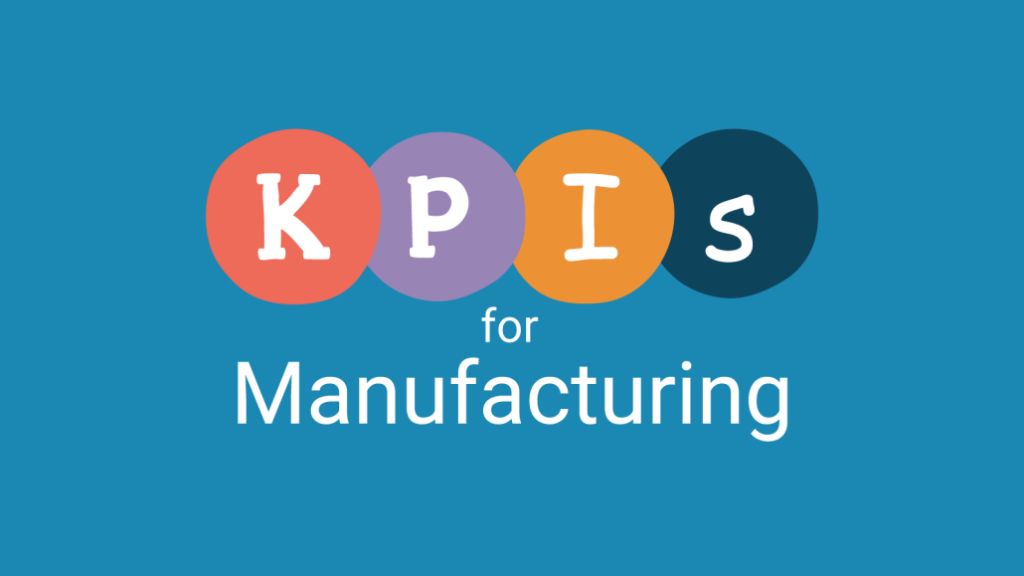
Key performance indicators
Key performance indicators or KPIs are one of the tools of business intelligence or BI business intelligence that helps the manager and business owner to check the status of various processes of the organization and identify the weak and strong points. In this article, the modirfa team examines the key performance indicators of the production process. After reading the article, you can discuss any question with our consultants.
Key Performance Indicators (KPI)
KPI or key performance indicator or production metric is a well-defined measure for monitoring, analyzing and optimizing production processes with respect to quantity, quality and also different aspects of cost. They provide manufacturers with valuable business insights to achieve organizational goals.
Today, controlling and optimizing the entire production process, ensuring that equipment is working at an optimal level, and constantly reducing maintenance costs are essential elements of positive growth in the industry. Turning to production analytics is a clear way to achieve this growth by using interactive metrics and automating many aspects of data management.
With that said, here is a complete list of 18 key manufacturing performance indicators and metrics that every manufacturer should know:
Key performance indicators in production
1- Production volume: As much as you can produce
Evaluate your production volume over time
Our production KPI gives you an overview of what your factories can produce in a month, a period of time or a year. After that, you will have a big picture of what your business is doing and for how long. Comparing it with previous similar periods with the help of a dashboard is a good indicator of evolution, to avoid anomalies, regression or progress. Similarly, measuring which machine accounts for what percentage of production can give you an idea of their performance and importance – no one wants to see a 45% production machine fail without a Plan B.
- A good production volume is a volume that meets demand but does not leave too much inventory in warehouses.
2- PRODUCTION DOWNTIME: Analyze and optimize your maintenance
Optimize your maintenance regularly
One of the most important production metrics to track is production downtime. If your machines don’t work, the result is money that can’t be earned: Minimizing downtime should be your number one goal to avoid further lost profits. When a production stoppage occurs, it is necessary to report the reasons why it happened, because this is the only way you can track the problems, evaluate them and then acknowledge what needs to be fixed.
Downtime can also be scheduled, when equipment needs maintenance, or during breaks and lunch breaks: That way, you can not only optimize it, but also keep it under control by preventing machines from breaking down, or running out of inventory.
- Try to minimize your downtime as much as possible. Monitoring helps you improve processes, increase profitability, and evaluate equipment effectiveness.
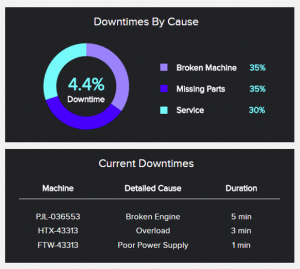
3- Production costs: Monitor implicit costs in production
Monitor the costs implied in the production
Product costing determines how much each component of your product costs. Dividing this production measure into different types of costs will tell you which ones contribute the most to your unit and can help if you want to track different costs that can be optimized.
It’s good to track these production costs over time to know how they evolve and if you can stay below the target price per unit you set at the end of the day to make it profitable.
- Measure your business’s overall unit costs over a production cycle, and see if that makes you profitable at the selling price you want to set.
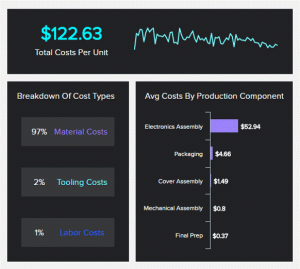
4- OVERALL OPERATIONS EFFECTIVENESS (OOE): Evaluate your operational efficiency.
One of the production criteria, which includes availability in calculations as well as standard time and off standard time, overall operation effectiveness (OOE), looks at the total operation time as the maximum value. This means multiplying performance by quality and availability, where availability equals actual production time divided by operation time.
- Track this metric to get a clearer picture of how your production process is performing and improving over time.
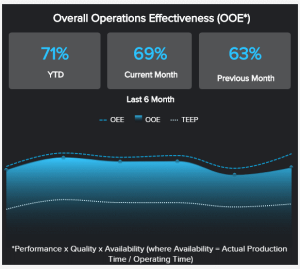
5- Overall Equipment Effectiveness (OEE): Evaluate planned performance.
Assess the scheduled efficiency of your equipment
If you need to paint a complete picture of quality KPIs in manufacturing, you need to consider overall equipment effectiveness (OEE). This measure only includes scheduled time, so if the device is not scheduled or maintenance is performed, OEE does not take this time into account. Basically, this performance index, quality and availability are the 3 parameters of this index and a number will be between 0 and 1.
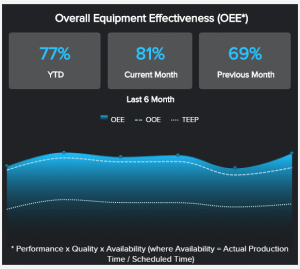
6- TOTAL EFFECTIVE EQUIPMENT PERFORMANCE (TEEP): Track overall effectiveness
Monitor the overall efficiency of your equipment
Compared to OEE, which measures planned uptime, total effective equipment performance (TEEP) includes the total hours we have available, 24 hours a day, 365 days a year. Similar to other effectiveness-focused metrics, this production KPI also considers availability, performance, and quality. In a perfect world, TEEP would reach 100%, meaning that facilities and production lines are always operating at optimal speed and without defective products. The goal is to increase the percentage as much as possible and actually identify the untapped potential that your facility is dealing with. In this way, you, as a manufacturer, have the possibility to increase production without investing in new equipment.
- This metric helps you assess how much of the production process you are not using. Therefore, it makes sense to track it regularly to reassess your production schedule.

7- Capacity Utilization: Maximize the use of your capacities.
Maximize the use of your capacities
How much capacity do you use in your production line? This is one of the measures of production efficiency that will answer this important question. The equipment is expensive, the building that houses your production is expensive, the machines that make your goods are expensive. The point is to maximize capacity utilization so that your machines are operating at an ideal cycle time and determine whether you need to scale your production or find out if you are struggling with the process. Problems can cause monetary losses and inefficiencies in your capacity management, where every machine and product matters.
- Maximize your capacities to avoid impacts on the effectiveness of your machines and facilities. Otherwise, you will face financial loss in the long run.
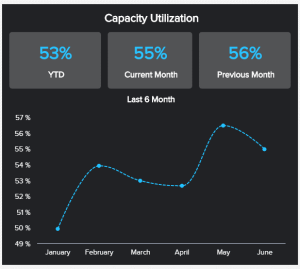
8- Defect Density: Track damaged items immediately.
Track the damaged items right away
Evaluation of defect density is an important task in the production environment. This is a key quality indicator that is easy to measure. Defect density determines the number of defective products over the total number of products produced. A production benchmark like this allows you to compare the quality of your different products. It is useful in identifying areas where problems occur and allows you to take the necessary steps to correct it. Working with this criterion along with other appropriate criteria will help increase efficiency in your production process and ultimately prevent unnecessary costs.
- Try to keep your defect density as low as possible and compare it with industry benchmarks (similar industries).

9- Rate of Return: Calculate the number of items to be returned.
Measure how many items are sent back
Return rate evaluates the percentage of products that customers return to you. Product returns are avoidable costs because they are products that need to be reprocessed. They may have been returned to you for any reason: Defects, wrong packaging, non-conformance, etc. Doing this will not only save you money, but also give you a better image in the eyes of your customers, who will see you as more trustworthy. You can also assess which products are most likely to be returned to analyze and take appropriate corrective actions.
- Try to keep the return rate as low as possible and evaluate the reasons for returns for your different products.
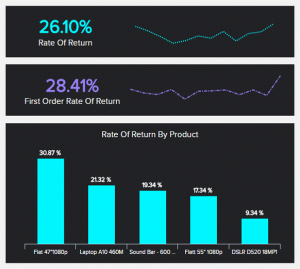
10- On-Time Delivery: Make sure your products are delivered on time.
Ensure your products are delivered on time
The list of our top manufacturing KPI examples goes on and on. This is a simple metric that shows the percentage of products delivered on time, and the goal should be 100%. Customers are important and if they receive your products on time, their satisfaction will increase and your relationship with customers will flourish. On a side note, if your employees manage to deliver 100% on time, it makes sense to reward them and keep them motivated. Here it makes sense to maintain a realistic production schedule, maintain an accurate inventory of materials, and create a culture focused on quality – your customers will thank you in the end.
- The higher this percentage, the better chance you have of increasing customer satisfaction. Don’t forget to reward your employees too.
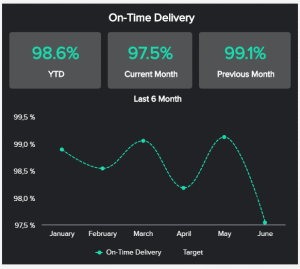
11- Right First Time: Understand the performance of your manufacturing process.
Measure your production performance
The need to rework a product is costly and represents a certain inefficiency in your supply chain. Using this production measure, you know how often you can produce something without any defects throughout the entire production process. After measuring your rework ratio, the next important step is to investigate where and when failure occurs, find the root cause, and work on it to prevent similar problems in the future. Comparing it with similar time periods over the years is an interesting analysis. Setting a target percentage is also a good motivation for better performance.
- First Time Right = (Number of Defective Products / Total Products) x Once you’ve evaluated this ratio, set a goal you want to exceed.

12- Asset Turnover: Confirm your assets in relation to your income.
Acknowledge your assets in relation to your revenue
Asset turnover is actually more of a financial aspect than a production KPI. However, it is widely used in many different industries because of the important insights it provides. It represents the value of your business’s revenue (or sales) relative to the value of your assets. It’s a good performance indicator to assess whether your assets are generating value, and even more important if you evolve in an asset-heavy industry like the automotive industry. It is interesting to compare this ratio, but it can only be done within the same industry
- Asset turnover = revenue / total assets.
- The higher the ratio, the better, because it means you’re generating more income per dollar of assets.
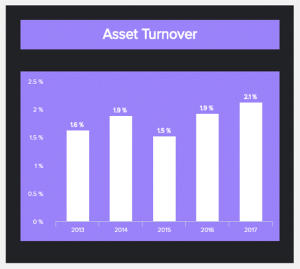
13- Unit Costs: Track and optimize your unit costs over time.
Track & optimize your units’ costs over time
This production KPI evaluates the total costs associated with the production of a product, including fixed costs and variable costs. This unit cost can also be broken down and analyzed to show all costs (labor, warehousing, equipment, materials, etc.) what the main inputs are and how much it represents in total. Note that sometimes they cannot be accurately measured, for example, due to volatile energy costs. Showing them with a trend over time helps to analyze the evolution and see if your business can stay below the target unit costs to have a profitable product.
- Identify manufacturing processes you can optimize to reduce unit costs over time.
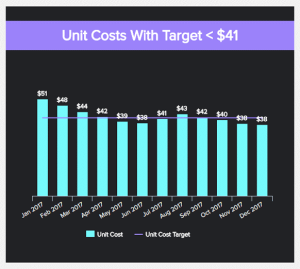
14- Return on Assets: See how profitable your business is relative to its assets.
Track your company’s capacity to generate profit
Return on assets (ROA) is another productivity measure that is borrowed as asset turnover from sales. This indicator shows how profitable your business is relative to your total assets. In other words, this index measures your efficiency in using assets to generate profit. Since this KPI tells you what income has been generated from the capital you have invested, it can also be seen as return on investment (ROA). It is a good indicator of performance because it looks at both the profits and the assets a company needs to support its business activities.
- Return on Assets = Net Income / Total Assets.
- Again, the higher the percentage, the better for your company. Set a benchmark for other businesses in your industry.
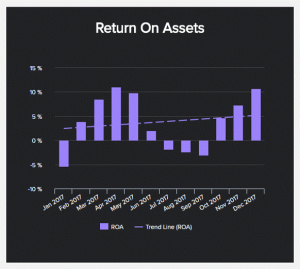
15- Maintenance Costs: Evaluate your equipment costs in the long run.
Evaluate how much your equipment costs
After evaluating your assets, how much they produce and the income you get from them, you can’t let them wither away, so maintenance is required. That’s why it’s so important to measure these production KPIs to know which equipment needs more work than others, where resources should be focused, and what kind of preventative measures can be taken to optimize that maintenance for the future. . Set a target cost for proper maintenance that leaves enough money for other investments, and try to reach it. Compare your preventive and corrective costs, as the former should reduce the latter if done well.
- Try to optimize maintenance costs over time and adjust your target accordingly.
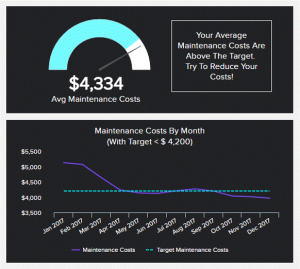
16- Revenue per employee: Measure the success of your workforce.
Measure the success of your workforce
, this KPI gives a strong signal to evaluate the level of efficiency and productivity – the higher this value, the higher the productivity. It is calculated in this way: by dividing the company’s income by the number of current employees. In essence, it represents the success of a manufacturing company and is connected to the financial sector as it directly involves costs. This KPI in manufacturing is typically monitored by C-level management, as it provides a clear picture of whether the business is growing or needs additional strategic evaluation and optimization. Keep in mind that revenue will vary based on geographic location, subsidies, and the level of automation included in the facility. Cheaper labor costs mean less automation because more human labor can man the machines.
- Make sure that the income of each of your employees is growing steadily to ensure that the entire company is on a sustainable development path.
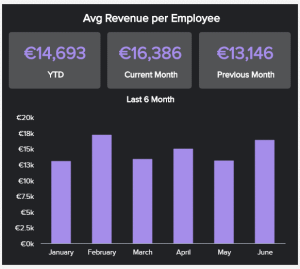
17- Waste Volume
The amount of waste, in addition to showing the amount of defective products of an organization, also indicates the products that have defects that cannot be corrected, repaired and recycled. Even products with lower quality that may be sold at a lower price than the price of healthy products can be considered part of the waste statistics.
18- Inventory Turns: Optimize your inventory turnover.
Inventory turnover is a measure of how often inventory is turned over, and is useful for both MRO (maintenance and repair) and product inventory. If your inventory is turning over faster than you can produce an item, it may be a sign that you need to improve productivity in some way. On the other hand, if it’s too low, you might hang on to the product for too long and spend more than you need to maintain it.
- For most manufacturers, MRO inventory doesn’t even change once a year, which often increases shipping costs.


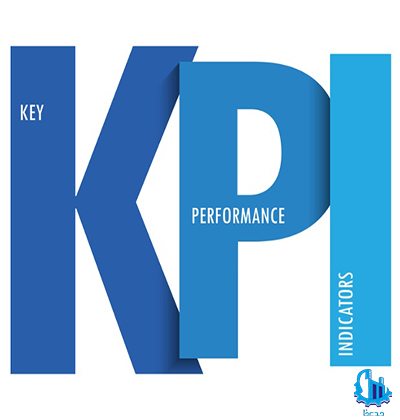
No views